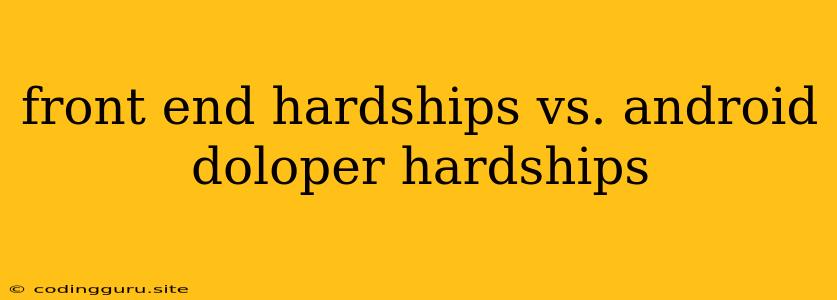Front-End Hardships vs. Android Developer Hardships: Which Path Is More Challenging?
Choosing a career path in software development can be exciting, but it’s not all sunshine and rainbows. Both front-end and Android development present their unique challenges, forcing developers to constantly learn and adapt. So, which path is tougher? Let's dive into the common hardships faced by both front-end and Android developers and explore which path might be more demanding.
Front-End Hardships: The Aesthetics of Complexity
Front-end development, the art of creating the user interface and user experience (UI/UX) that users interact with, often involves a seemingly endless list of frameworks, libraries, and tools.
1. The Ever-Evolving Landscape:
- Front-end development is a rapidly evolving field. New frameworks like React, Vue.js, and Angular emerge regularly, demanding constant learning and adaptation. Keeping up with the latest trends and technologies can feel like a race against time.
2. Browser Compatibility: A Cross-Browser Nightmare:
- Ensuring a website or web application looks and functions flawlessly across different browsers (Chrome, Firefox, Safari, etc.) can be a true nightmare. Different browsers have different rendering engines and support for various technologies, leading to inconsistencies and bugs.
3. Responsiveness and Optimization:
- Websites and web apps need to be responsive, meaning they must adapt seamlessly to various screen sizes (desktops, laptops, tablets, and smartphones). Achieving optimal performance across different devices is a constant battle, requiring a deep understanding of web performance optimization techniques.
4. Accessibility: A Crucial but Often Overlooked Aspect:
- Making websites accessible for users with disabilities (including visual impairments, motor impairments, and cognitive disabilities) is a crucial but often neglected aspect. Ensuring that your website adheres to accessibility guidelines (WCAG) adds another layer of complexity to front-end development.
5. The Pressure to Create Beautiful and User-Friendly Experiences:
- Front-end development is not just about coding; it's about creating engaging and intuitive user experiences. The constant pressure to design aesthetically pleasing, user-friendly interfaces can be challenging, especially for developers with limited design experience.
Android Developer Hardships: The Deep End of the Mobile World
Android development, the process of creating applications for the Android operating system, comes with its own set of hurdles. While Android is a dominant mobile platform, its vast ecosystem and fragmented nature pose unique challenges for developers.
1. Fragmentation and Compatibility:
- Android devices come in various shapes and sizes, with different hardware configurations and software versions. This fragmentation can lead to compatibility issues and difficulties in optimizing apps for diverse devices. Testing your app on multiple devices and Android versions is essential to ensure smooth functionality and performance.
2. The Complexity of Android Development:
- Android development involves a steep learning curve. Developers need to master the Java programming language (or Kotlin), understand Android Studio, and navigate through a complex set of APIs and libraries.
3. The Ever-Changing Android Ecosystem:
- Google frequently releases new versions of Android, bringing updates to APIs, SDKs, and design guidelines. Developers need to keep their apps updated and compatible with the latest Android versions, leading to constant learning and adaptation.
4. The Challenge of Optimizing Performance and Battery Life:
- Android apps need to be optimized for performance and battery life, especially on less powerful devices. This requires careful resource management, efficient code execution, and an understanding of Android's power management features.
5. Navigating the Google Play Store:
- Getting your app published on the Google Play Store is only the first step. App promotion, user engagement, and navigating the ever-changing Google Play Store policies can be daunting for developers.
The Ultimate Comparison: Which is Harder?
Both front-end and Android development are challenging paths with unique sets of hurdles. The difficulty level can vary depending on individual skill sets, experience, and personal preferences.
Front-end development might be seen as more challenging due to its rapidly evolving landscape, demanding continuous learning, and the complexity of browser compatibility. The pressure to create visually appealing and user-friendly interfaces can also add to the difficulty.
Android development poses its own challenges, primarily due to fragmentation, the need to handle different screen sizes and hardware configurations, and the complexity of the Android ecosystem. The learning curve for Android development can be steep, requiring expertise in Java (or Kotlin) and Android Studio.
Ultimately, the "harder" path depends on individual preferences and strengths. If you enjoy working with visual design, user interaction, and are comfortable with fast-paced technological changes, front-end development might be a good fit. If you thrive on technical challenges, enjoy working with mobile devices, and have a knack for solving complex problems, Android development could be the path for you.
Conclusion:
Both front-end and Android development offer rewarding career paths with unique challenges. The "harder" path is subjective and depends on individual preferences and skill sets. Choosing a path that aligns with your interests and strengths will set you up for success in the exciting world of software development.
